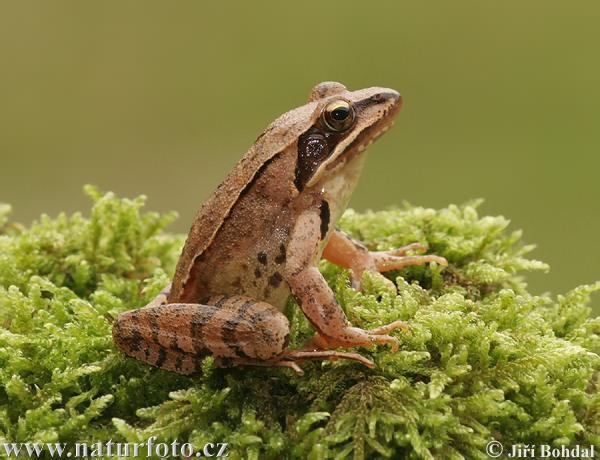Scientific classification:.
Kingdom: Animalia
Phylum : Chordata
Class : Amphibia
Order : Anura
Family :Ranidae
Genus: Rana
Species : R. dalmatina
Distribution, place of living
In whole Middle- and South-Europe, but they can be found even int the west part of Asia.
In Hungary they inhabit both plain and hilly countrysides. They prefer woods, flood willowy, wet meadows in the wood. Their favorite habitat are the flood woods. They spent the winter in mud.
Morfology and phisilogy:
Medium-sized, thin-bodied frog, body size may reach 5-7 cm, the females mey be even higher. Pointed nosed with brown eyes and horizontally curved iris. Its base colour is beige-brown ont eh legs and back with some darker spots, its belly is slightly yellowish, sometimes with a hint of pink . Against the commos frog unicoloured, without marbled effects, on its back there is generally a darker V shaped patch. Its eardrum is smaller and is closer to the eyes that at the turf frog. Ont he hind legs generally well visible the ca. 10 squer stripes.The wood frog has the longest legs,folding the back legs back along the body, the ankle-point exceeds the top of the nose. The most capable jumper, the moutache frog can jump over 1,5 m.
Nourishment:
Eats insects, worms and snails. Quickly stiks out its sticking toungue. Quickly catck prays. He is fond of spiders, inssects, worms, and slugs .
Habits:
Hibernate from October to March. Reappers only int he second half of May, and soon he lays the eggs. Only in this period can be found in the waters. The adult animals spend the days in the vegatation or under the forest mould, buti n clouudy, humid whether are mostly active during the day.
Reproduction:
In February after mating the female lays her eggs (600-1500 pieces). Within a few days out of the eggs develop thousands of tapdoles. Transforming into small frogs after 2-3 moths they move to the mainland. After laying eggs the frog rather stays int he wood. Int he water living and gills brathing tadpols metamorphose into frogs breating by lungs and living ont he main land.
Danger
The animals live in mountainous areas – particularly in the arid moutains - find only very few suitable breeding places, therefore are forced to lay eggs in wheel-track and other quicly drying waters. It has negative affect on the stock of certain areas, because they ofter dry up before the metamrphosef of the tadpols. Non endangered species. In Hungary is a protected specie. its theoretical value: HUF 2.000,-
